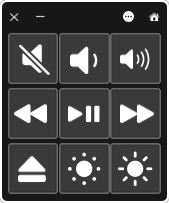Short guide:
- Click the Apple icon
 in the top left corner of the screen and select System Settings.
in the top left corner of the screen and select System Settings. - Click Accessibility in the sidebar.
- Select Switch Control from the list of Accessibilty options on the right.
- Turn on the toggle switch for Enable Switch Control.
- By default, you can press the Space bar on your keyboard to start scanning the Switch Control Home panel. Press the Space bar again to select the highlighted item. You can add more switches in the Switches section.
Before and after
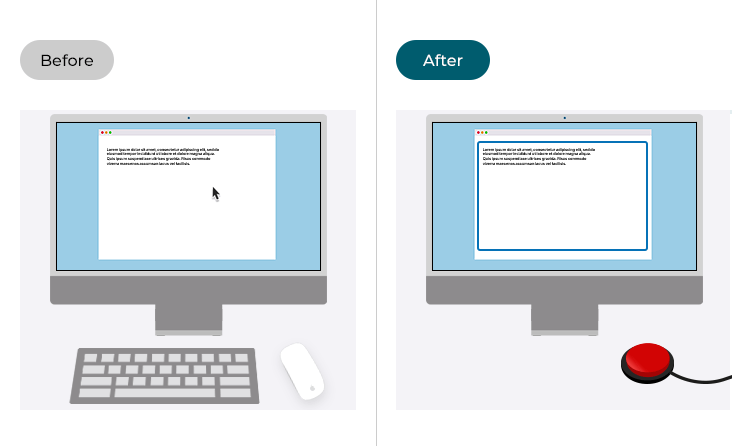
This section gives you step by step instructions on how to enable Switch Control in macOS 13 Ventura, with pictures of the screens to help.
Open System Settings
1. Click the Apple icon ![]() in the top left corner of the screen and choose System Settings from the menu.
in the top left corner of the screen and choose System Settings from the menu.

Open the Accessibility settings
2. In the System Settings window, click Accessibility in the sidebar.
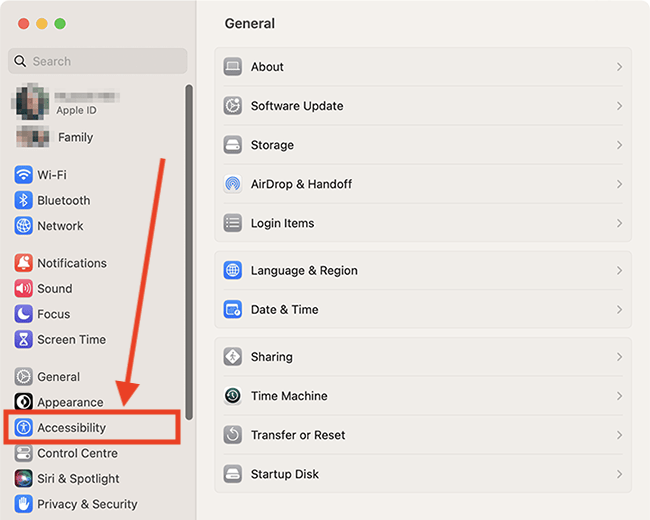
Find the Switch Control settings
3. Select Switch Control from the list of Accessibilty options on the right.
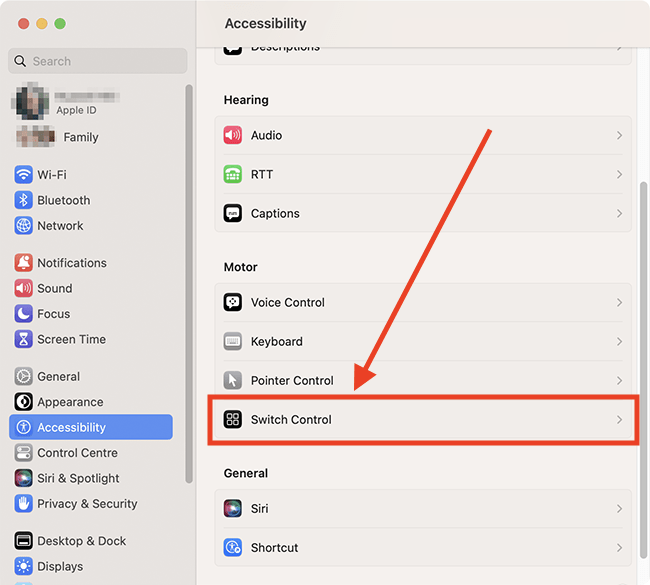
Turn on Switch Control
4. On the Switch Control page, click the toggle switch for Switch Control to turn it on. Note: You may be asked to enter your password and/or confirm you want to enable Switch Control.

How to use Switch Control
5. When you enable Switch Control, the Switch Control “Home Panel” will appear on the screen and the Space bar on your keyboard becomes the default “Select Item” switch – the switch you press to select the item currently highlighted on-screen. You can change this and add more switches to perform other tasks, but we will cover that later in this guide.

6. Press the Select Item switch to start auto-scanning. Auto-scanning highlights the items in the Home Panel one after the other. To select a highlighted item, press the Select Item switch again.
The items on the Home Panel
|
Keyboard |
|
|
Pointer |
|
|
Dock |
|
|
Menu Bar |
|
|
System |
|
|
Custom |
|
|
Location |
|
|
Devices |
|
|
Close button |
|
|
Home button (shown on sub-panels)
|
|
| |
Options button (shown on sub-panels)
|
How to move the pointer (and select an item on the screen)
Open the Pointer panel
7. Scan the Home Panel and select Pointer.

Choose the pointer

8. On the Pointer panel, select Move or Move and Click.
Move the pointer
9. Vertical lines, followed by horizontal lines, will move across the screen so that you can pinpoint where you want the pointer to move to. Press the Select Item switch to stop the lines at the required location. When you stop the horizontal line, the pointer will move to the intersection of the two lines. If you selected Move and Click, the pointer will move to and select the item located at the intersection.
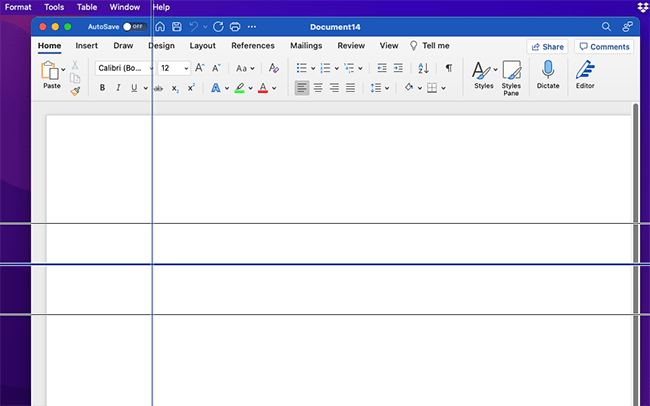
How to add a new switch
10. On the Switch Control settings page, scroll down to the Switches section.

Add a switch
11. Click the + (add) button, then press the switch you wish to add when prompted.

Name the switch
12. The computer will detect the name of the switch but you can type your own name for it if you prefer.

Choose the action you want the switch to perform
13. On the next screen, choose the action you want to perform when the switch is pressed. Select the Action drop-down menu and choose from:
- Restart from the top
- Select Item
- Move to next item
- Stop scanning
- Open Application
- Run Shortcut

Choose what happens if you press and hold the switch
14. Select the Press and Hold drop-down menu and choose Does nothing or Repeats Current Action.

Save the new switch
15. To save the switch, click the Done button.

Turn off auto-scanning
16. If you have set up a switch to perform Move To Next Item, you can turn off auto-scanning and use that switch to move between items. Set the toggle switch for Auto-scanning to turn this off.

Change the switch timing settings
17. You can set the timing before an action is performed after activating a switch. To do so, click the Switch Timing button.

18. In the pop-up window, adjust the timing for the following options as required:
- Hold before perform duration – set how long a switch needs to be held before an action is performed.
- Ignore switch repeats – set the duration in which subsequent presses are ignored.
- Hold before repeat duration – set how long a switch needs to be held before an action is repeated.
Click the Done button when you are happy with your Switch Timing settings.

Change the appearance of Switch Control panels
19. By default, the Switch Control Panel is black, with white text and icons. To change this to black text and icons on a grey background, choose the Light option for Appearance.

Hide the Switch Control panel after a period of inactivity
20. To automatically hide the Switch Control Panel when it is not in use, tick the checkbox for Hide panel after inactivity. Note: The panel will re-appear when you press a switch.

Set how long the period of activity needs to be before the Switch Control panel is hidden
21. To set how long the period of inactively needs to be before the panel is hidden, adjust the seconds setting for Duration of inactivity.

Control your computer using switches on another device
22. You can use another Apple device, such as an iPhone or iPad, that is already set up to use switches, to control your computer. To enable this, click the toggle switch for Allow platform switching to control your computer to turn it on. You will be asked to enter your password to confirm this. Note: Your computer and the device you wish to control must be connected to the same Wi-Fi network and must be signed into the same iCloud account.
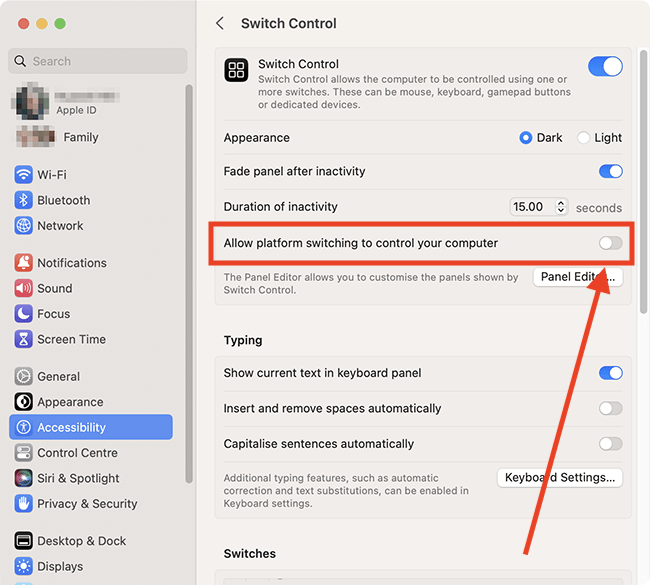
Create your own custom panels
23. Panels are customisable collections of buttons that perform various tasks on your computer, such as entering pre-written text, opening apps, running shortcuts, or performing advanced mouse actions. Click the Panel Editor button to start creating your own panels.
For more information on creating your panels, see our guide How to create panels to use with Switch Control and the Accessibility Keyboard in macOS 13 Ventura.

Typing settings
24. These are settings to make it easier to use the on-screen keyboard panel. Scroll down to the Typing section. Set the toggle switches for the following options to on or off as required:
- Show current text in keyboard panel – show the text you are typing at the top of the on-screen keyboard.
- Insert or remove spaces automatically – Switch Control will correct spacing after a full stop or between sentences.
- Capitalise sentences automatically – Switch Control will capitalise words based on context, for instance, capitalising the next word after a Full stop.
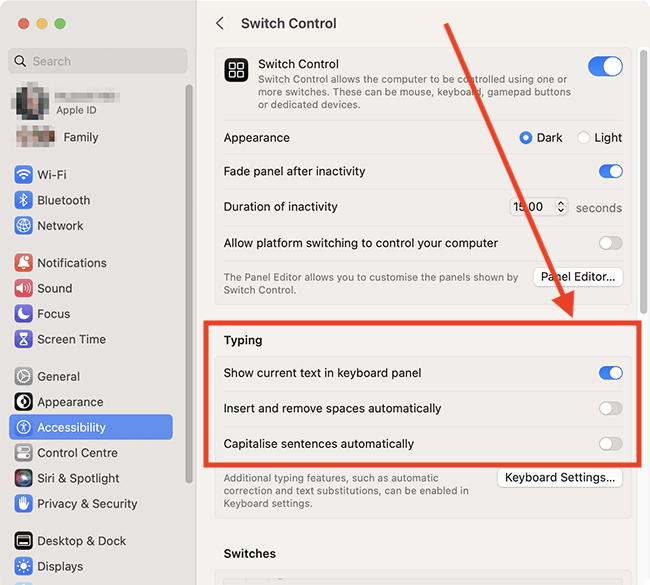
Customise Switch Control navigation settings
25. Scroll down to the Navigation section. You can edit the following settings:
- While navigating – choose what feedback you receive when an item is highlighted during a scan. Choose from: Do nothing, Speak selection, Play sounds, Speak & Play sounds.
- Restart position – choose where to start from when you rescan an item. Choose from: After Cursor, From start of group, From the top.
- Resume auto scanning after selection – by default, scanning pauses when an item is selected. You will need to press the Select Item switch again to resume scanning. If you would prefer scanning resumes as soon as the selected option loads, turn on the toggle switch for Resume auto scanning after selection.
- Reverse cursor direction after hitting edge – choose what should happen when the pointer meets the edge of the screen. By default, nothing happend when the pointer reaches the edge of the screen. To set it so that the cursor comes back in the opposite direction, turn on the toggle switch for Reverse cursor direction after hitting edge.
- Switch Control cursor size – by default, a thin rectangular border is shown around the currently selectable item. To make the border easier to see, select the drop-down menu and choose Medium or Large.
- Pointer precision – select High to slow down the moving blue lines used to position the pointer when you use Move or Move and Click. This makes it easier to accurately position the lines.
- Loops – by default, Switch Control scans a panel, group, or window twice before stopping if an item isn’t selected. You can choose up to 10 loops.

Change navigation timing settings
26. To change the navigation timing settings, select the Navigation Timing button.

27. In the pop-up window, you can change the timing settings for:
- Gliding & rotating cursor speed – The speed that the blocks and blue lines move across the screen when positioning the pointer.
- Auto scanning interval in panels – The number of seconds it takes to move from one item to another in a panel when using auto-scan.
- Auto scanning interval in interface – The number of seconds it takes to move from one item to another in the user interface when using auto-scan.
- Pause on first item – the number of seconds auto-scanning stays on the first item in a panel, group, or user interface before scanning begins.
Click the Done button when you are happy with your Navigation Timing settings.

Close System Settings
28. When you are happy with your settings, close System Settings by clicking the Close button (red circle) in the top-left corner of the window or using the Cmd + W keyboard shortcut.
Note: If this does not work it could be because your computer settings are managed by someone else (an IT department or administrator for example). If so, you will need to contact them to access these settings or for help.


